Astronomers have used the youngest objects in the Milky Way to build a new map of the galaxy’s spiral arms, and the results are far messier than expected.
Even though the spiral arms of a galaxy look stunning and impressive, they are not much denser with stars than the gaps between them. A typical spiral arm has only about 10% more stars than average, so spiral arms aren’t regions of greater stellar concentration.
Instead, the arms represent places of greater-than-average star formation. The arms are density waves, their formation triggered by gravitational interactions with satellite galaxies, that travel through a galaxy at their own speed, like ripples in a pond. As the waves travel, they slightly increase the density in that region of space as they pass by. When that happens, clouds of gas destabilize and collapse, leading to a new round of star formation.
Related: The Milky Way galaxy may be a different shape than we thought
Those clouds go on to form all sorts of stars, from small red dwarfs to blue giants. Those giant stars don’t last long; a typical star of that size lasts only a few million years. By the time the spiral density wave finishes passing through, all of those stars will be gone, leaving behind only their smaller, dimmer siblings.
So, when we look at a galaxy from afar, the bright giant stars outshine all the others, highlighting the appearance of the spiral arms.
Young clues
It’s relatively easy for astronomers to map the spiral structures of many distant galaxies, especially if they appear to us face-on. But creating a detailed map of our own Milky Way’s arms is much more difficult.
Because we are embedded within the same galactic disk as the arms, we have to contend with tens of thousands of light-years of gas and dust, which are very effective at blocking many wavelengths of light, to make our observations. And so our maps of the Milky Way are surprisingly vague and filled with guesswork.
Recently, however, a team of astronomers developed a new map of the spiral structure of the Milky Way and reported their results in a paper published in The Astrophysical Journal in April. To build their map, the astronomers focused on observations of three kinds of objects: high-mass star-forming regions, bright young stars, and young open clusters. All three of these object types represent fresh rounds of star formation in their own way, so they all should prove to be relatively reliable tracers of spiral arms.
The high-mass star-forming regions are dense clouds of gas and dust that are actively forming giant stars. The interplay of radiation from the stars with the gas in the clouds generates “masers,” naturally occurring microwave lasers. Very long baseline interferometers, which are networks of telescopes scattered across the globe, have allowed researchers to measure the distances to dozens of these masers throughout the galaxy.
Because giant stars do not live long, they do not have a lot of time to move away from their birth locations. Thus, where we see them today should be near the location of a spiral arm. The team used the positions of over 23,000 young stars from the Gaia catalog. By using only young stars with high-precision positions, the astronomers could ensure that they were closely mapping the locations of spiral arms.
Lastly, the team used the locations of known young open clusters. Open clusters are associations of stars that formed from the same gas cloud but have not yet had enough time to drift away from each other. So these clusters, of which the team used nearly 1,000 samples, should be able to tell us where the spiral arms are.
A new map
Despite the volume of data, the locations of all of these young objects doesn’t even come close to covering the entire Milky Way. Instead, the researchers had to take the best-fit locations of the spiral arms in our local vicinity and extend them, reconstructing the entire lengths of the arms all the way from the edge of the galaxy back to the core.
They found a total of seven spiral arms. Two of these, the Perseus and Norma arms, dominated the others; a distant observer would see these two arms stand out much more clearly. These arms begin at opposite ends of the Milky Way’s elongated core and wrap around each other, forming a symmetrical S-shaped pattern.
The other five arms — the Carina, Sagittarius, Centaurus, Outer and Local arms — don’t extend nearly as far as the major two. Instead, they begin either as forks of the major arms or as loose segments of their own, neither of which wraps entirely around the galaxy.
From a distance, our galaxy would be beautiful, if a bit messy. The two major arms would elegantly encircle each other, while the additional arms would fill in the gaps to create a grand display.

